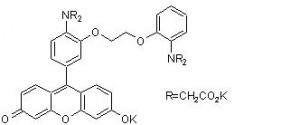
G Protein Coupled Receptors (GPCR) and ion channels are important targets in drug development. Both target classes represent membrane proteins which require convenient and robust cell-based assays for screening campaigns. Usually used as readout of such screenings, intracellular Calcium concentration implies the use of Ca2+ indicators able to meet demanding expectations of researchers engaged in assay development and screenings.
Measurement of intracellular Calcium based on fluorescent dyes
Commonly used tools to directly measure Calcium are Ca2+ chelators – in this case fluorescent dyes which directly bind Ca2+. Upon binding, the fluoresence intensity is significantly increased and can be easily measured by fluorimetric instruments. Classical dyes are Fura-2, Indo-1, Fluo-3, Fluo-4.
Fluo-8 (chemical structure, see Fig 1) can be considered as the state-of the-art indicator for measuring intracellular Ca2+ concentration, as it has 3 main benefits over classical fluorescent dyes:
- Twice as bright as Fluo-4 and four time brighter than Fluo-3
- Loading of the cell can be conducted at room temperature, meaning under less harsh conditions than with Fluo-3 and Fluo-4 which require 37°C for optimal loading.
- As especially HTS screening requires homogeneous assays (assays not requiring any wash steps to be HTS compatible), a Fluo-8 no wash kit is available as well.
 Fluo-8 dye is twice brigther than Fluo-4.
Fluo-8 dye is twice brigther than Fluo-4.
Interested in testing our Fluo-8?
Just contact me with the form below.
 Rat embryo fibroblasts before and after stimulation with 2 µM Ionomycin and loaded with Fluo-3, Fluo-4, or Fluo-8.
Rat embryo fibroblasts before and after stimulation with 2 µM Ionomycin and loaded with Fluo-3, Fluo-4, or Fluo-8.


